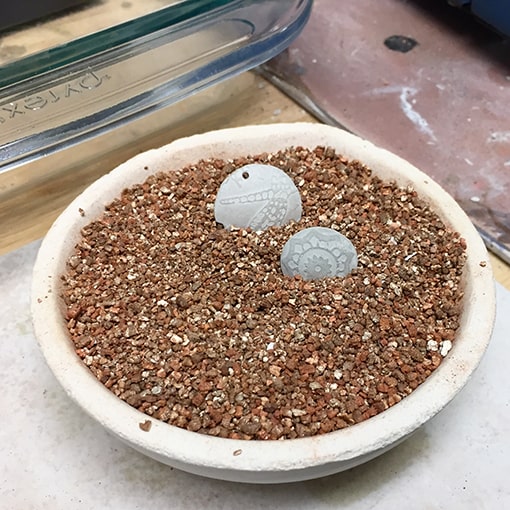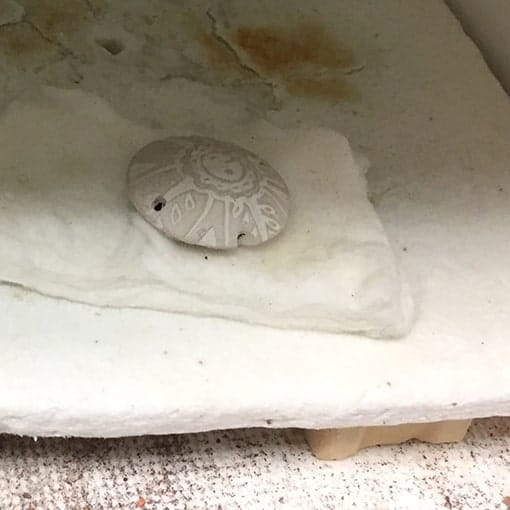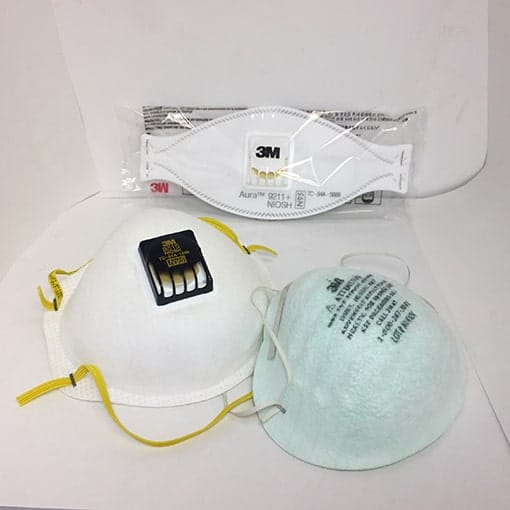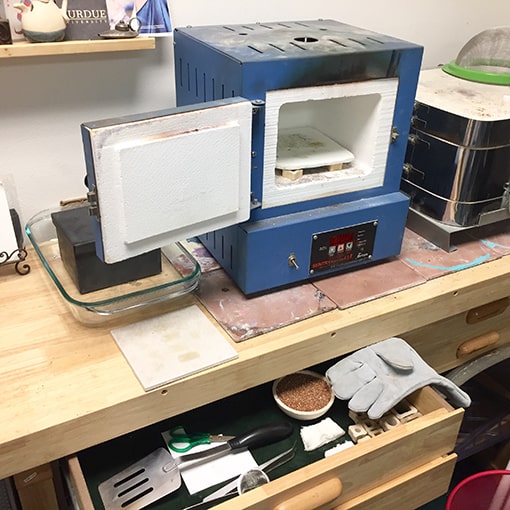Safety, Metal Clay, and You
Pure silver and gold are not only used to manufacture jewelry and other precious objects, but they have also been used internally as health remedies and in food preparations for centuries, and are even considered kosher. When fine silver and 22k gold are combined with a non-toxic, organic binder to create metal clay, the resulting material is also non-toxic and safe to use.
In fact, Mitsubishi Materials’ Precious Metal Clay (PMC) has been certified by an independent testing facility to be safe and conforms to ASTM D4236 standard. Aida Industries’ Art Clay Silver and Art Clay Gold clays have been awarded the Art & Creative Materials Institute, Inc. certification seal for safety in educational use.
However, some people are more sensitive than others to metals, especially when dealing with base metal clays like copper, or alloys such as sterling silver and bronze. Some may develop a rash, experience itching, or notice a green discoloration on their skin after contact with these clay bodies.
The trace amounts of copper that may be absorbed into the skin while in direct contact are sometimes thought of as beneficial, but to prevent this reaction, you can wear gloves or apply a barrier skin cream when working with these products. Always wash your hands after using any metal clay and avoid eating or drinking in the work area.
Masks are widely available in lots of different styles
Sanding Dust
Another area that may cause sensitivity is sanding or filing metal clay. Inhaling small, airborne particles while working with dry clay may cause sinus, lung or throat irritation. Wearing a dust mask and gloves while handling metal clays will help to alleviate this issue.
- Wearing a good particulate mask is always advised when sanding during a class with several other participants.
- Always make sure there is good ventilation in the room, especially if you are sensitive or have health concerns.
Always torch fire in a controlled environment
- Place kilns on a non-flammable, stable surface and provide at least 12 inches of clearance around the entire circumference.
Always follow the manufacturer’s recommendations on kiln use and setup. - Protect your eyes when looking into the chamber of a red-hot kiln (even while using a viewing window) by wearing green, #3 safety glasses or goggles.
- As all metal clays have a small amount of non-toxic binder that burns off at about 800ºF, place the kiln in a well-ventilated room, in the kitchen while using a ducted range hood, or outside on a still day.
- Opening a window and using a fan to vent to the outside will allow fresh air to circulate while firing, but allowing a fan or the wind to blow into a kiln will change the interior temperature and may affect the success of the firing. The kiln could also be placed outside the studio or classroom while firing.
Firing
Precautions should always be taken when firing metal clay, either with a torch or in the kiln. A good first step would be to invest in safety equipment such as a fire extinguisher and/or a fire blanket.
Safety Tips for Torch Firing
- Remove all flammable objects and materials from the work area.
- Wear natural, less combustible fibers such as wool, cotton, or silk. Synthetic fabrics are much more flammable and will melt onto skin if they catch on fire.
- Tie back long hair.
- Don’t wear loose or dangling clothing including wide sleeves, scarves, and necklaces.
- Wear closed toe shoes in case hot work drops to the floor.
- Protect your eyes while working with an open flame by wearing green, #3 safety glasses or goggles.
- As all metal clays have a small amount of non-toxic binder that burns off at about 800ºF, make sure you are firing in a well-ventilated area.
Keep your kiln area clean and organised

Pieces ready to fire supported in vermiculite

Piece sitting on fiber blanket on a kiln shelf
Firing Supports
Some metal clay designs may require additional support during the firing process. The three most common materials used for support are:
- Vermiculite
- Ceramic fiber blanket
- Alumina hydrate
Vermiculite resembles small particles of granulated bark and is a mineral used in the gardening industry. It is non-toxic.
Ceramic fiber blanket is a fluffy, cotton-like pad that consists of interwoven, spun fibers and was originally designed to insulate pipes at high temperatures. It becomes friable after firing and care should be taken not to overuse it. Dispose of ceramic fiber blanket after it loses its loft and starts to degenerate.
According to its material safety data sheet, the fiber is an eye, skin and upper respiratory irritant. Dust generated from this product will contain respirable fiber. You can alternatively search for a bio-soluble fiber blanket which does not have any hazard classification due to its low bio-persistence and biodegradability, resistant to high temperatures reaching 1100ºC/ 2012ºF.[1]
Alumina hydrate, while considered by some to be very useful material, is a finely powdered feldspar product used in the ceramics industry, and is very dangerous when inhaled or ingested. Extreme care must be taken while using and handling this material. Gloves, particulate masks, and eye protection should always be worn when in use.
Patina Solutions
- LOS is available in a dry form, as a liquid, and as a gel. Both the dry and liquid forms quickly lose effectiveness when exposed to air or moisture. The gel is much more reliable and long lasting when stored.
- Use proper ventilation as liver of sulfur has a strong scent of rotten eggs
- Because LOS tends to quickly become inert, the used solution can safely be poured down the drain if you take care to run cool water through the pipes for a few minutes.
- LOS solution should be used warm for best patina results. While the bright colors are unstable in the long run, LOS progresses from gold to orange, to pink to teal, to purple to a final grayish black. The warmer the solution, the faster the patina will transform to the darkest color possible.
Liver of Sulfur (LOS) is a mixture of a variety of potassium products with long scientific names. Most of what you need to know is that it’s a salt, not an acid, and is not toxic when used for jewelry oxidation.
Weak solutions of hydrochloric acid are sold by the brand names Black Max™, Jax®, and more. When used in industrial applications, this liquid can be very destructive, but the products sold to the jewelry community are not as dangerous when treated with respect and knowledge.
- Hydrochloric acid should be used at room temperature, straight out of the bottle. This solution creates a rich black immediately that will be stable over time.
- Take care not to spill any on your carpet or on your clothes. By the third washing, you’ll notice small holes where the droplets fell!
- These solutions will erode thin metal parts.
- Decant into a wide mouthed plastic jar with a plastic lid if you like to dip your work, or use a water pen that does not contain any metal parts to brush the patina onto the work.
- All jewelry patinated with hydrochloric acid solutions will need to be neutralized in a bath of warm water and baking soda.
- If kept in a container, hydrochloric acid solutions can be used repeatedly until they are no longer effective. At that point, add baking soda until the solution stops foaming, then dispose of it. Check the regulations in your state and locality for the best method of disposal.
Always check the MSDS (Material Safety Data Sheet) of any product before using it.
Finishing and Polishing
Fired pieces of metal clay are, of course, metal – and are extremely hot immediately after firing.
- Allow them to cool naturally in air, or speed the process by dropping into cool water once the red heat has dissipated. This is called quenching.
- Never quench a piece that includes a gemstone or glass cabochon of any kind. These are prone to thermal shock, and will crack, haze, or shatter when dropped into water while hot.
- Use tongs, tweezers, or a long-handled barbeque spatula to transfer hot work from the kiln or torch firing location to a non-flammable surface to cool. Heat resistant gloves and long sleeves will help to deflect residual heat.
Using Power Tools
Drills, sanders, hand-held or pendant motor-tools all make an artist’s work easier – but always use proper precautions!
- Always wear proper clothing, tie back long hair, and avoid wearing loose clothing when operating power tools.
- Wear appropriate eye protection.
- For common dust, a dust mask will be sufficient, but for other types of dust, such as the kind created while using any variety of silicone polishing wheels or grinders, wear a particulate respirator.
- Work in a well-ventilated area or use a dust collecting machine to avoid inhaling the dust.
Always follow the manufacturer’s recommendations.
Safety, Metal Clay, and You
Following the manufacturer’s recommendations, being aware of your surroundings, and using common sense can eliminate most safety concerns.


